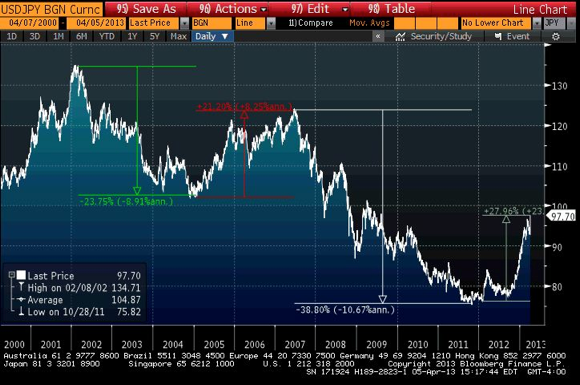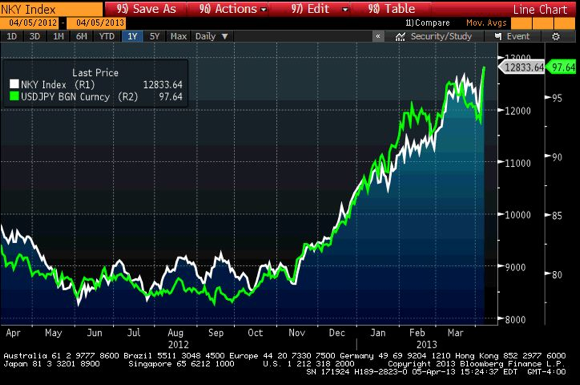- Is 110 Possible In USD/JPY?
- USD: Sticker Shock In Payrolls
- EUR: Potential For Rally To Extend To 1.3130
- CAD: Big Decline In Jobs Erase February Gains
- AUD: Surprise Weakness, Support Near
- NZD: Oil Continues To Fall, Gold Up 1.5%
- GBP: Upside Breakout Could Gain Momentum
USD/JPY has been on a tear this week thanks to bold and aggressive easing from the Bank of Japan. Over the past 48 hours, USD/JPY appreciated more than 5% and the last time we saw a move this large was in November 2011 when the BoJ intervened in its currency. When it comes to USD/JPY it is important to realize that trends in the pair can last for a very long time and extend further than what most would imagine. Between 2007 and 2011, the currency pair dropped nearly 40%. There were certainly recoveries along the way but they were brief and shallow. Before that between 2005 and 2007, USD/JPY rose 20% and a similar move was seen between 2002 and 2005. Over the past year, USD/JPY has already appreciated nearly 28%, leading many investors to wonder how high it can rise. Considering that the Bank of Japan has just begun easing, there's a lot more room to the upside. Its 10 year average is 100 and at minimum, we expect USD/JPY to rise to this level but 110 is also possible though 104.50/105 is a more realistic short term target.

Basically what the Bank of Japan has done is officially eliminate any reason to buy yen over the next two years. Their commitment to bold easing means they will do everything in their power to drive down yields, leading to a more aggressive shift out of Japanese bonds by domestic investors. They will look abroad for higher yields and they will do it on an unhedged basis as the BoJ's policies should lead to further weakness in the Japanese Yen. In other words, the central bank has effectively given Japanese investors a reason to go global. Their "Quantitative and Qualitative" easing is the central bank's boldest monetary policy program in recent history and as we have seen in Friday's reaction to the U.S. nonfarm payrolls report, it super cedes the ebbs and tides of the U.S. economy. In the long run, the Nikkei should also benefit from Japan's policies and as shown in the chart below, USD/JPY has a very strong positive correlation with the index so a further rise in Japanese stocks should help fuel the rally in USD/JPY.

USD: Sticker Shock In Payrolls
Between Friday's nonfarm payrolls report and yesterday's ECB/BoJ meetings, it has been a rock and roll week in the FX market. Volatility picked up significantly with breakouts seen in many currency pairs. Job growth last month was abysmally weak. U.S. companies added only 88k jobs in March, the smallest increase since June 2012. While the unemployment rate dropped to 7.6% from 7.7% and February numbers were revised up to 268K from 236K, the sticker shock of the sub 100k print sent the dollar tumbling. The improvement in the unemployment rate is misleading because the participation rate, which measures the number of people employed or actively looking for a job hit a 30-year low. For the Federal Reserve, this morning's jobs numbers will push their timeline out for varying asset purchases because a decline like the one seen Friday is the exact reason why the central bank is concerned about the sustainability of labor market improvements. Yet one monthly decline does not constitute a trend especially when it comes after a very strong month in February. Next week's retail sales report will be key. If consumer spending increases, the central bank may look past this month's decline in job growth. The manufacturing sector cut 3K jobs and losses were also seen in the public sector as private payrolls increased 95k. Average hourly earnings were flat but average weekly hours increased -- in other words, Americans are working longer and not making more. Lost in the shuffle was the trade balance, which narrowed from -$44.5B to -$43B in February. Aside from retail sales, the minutes from the most recent Fed meeting is also scheduled for release and while we expect more talk of varying asset purchases, after the payrolls report, some views may have changed.
EUR: Potential For Rally To Extend To 1.3130
It has been a great week to be long euros. Between ECB President Draghi's comments and the weak nonfarm payrolls report, investors have to come to realize that the European Central Bank is staring at an empty toolbox and will be reluctant to ease further while the Federal Reserve will postpone any plans to taper asset purchase after the disappointing NFP number. Their natural inclination will now be to reverse the short euro and long dollar trades placed in hopes that central banks would move closer to changing monetary policy this week. Euro zone economic data was weak and is now mixed and that was good enough for EUR/USD bulls who have taken the currency pair back above 1.30. While Euro zone retail sales dropped 0.3% in the month of February, German factory orders jumped 2.3%. This increase should bode well for next week's German industrial production and trade numbers. In the near term, we expect additional gains in EUR/USD but the pair may have difficulty breaking above last month's high of 1.3134 as the 50 and 100-day SMA also converge near that level.
CAD: Big Decline In Jobs Erase February Gains
The Canadian and Australian dollars fell sharply against the greenback. While disappointing economic data drove weakness in the CAD, the sell-off in the AUD was far more surprising. Most other major currencies including the New Zealand dollar rallied after the abysmal nonfarm payrolls report but the AUD fell more than 50 pips and held onto its losses. Economic data from Australia has been good and AUD/JPY has been on a tear, but the sell-off in the AUD/USD was inconsistent with Australian fundamentals. Support should come soon between 1.03 and 1.0350. The Canadian dollar on the other hand had very good reasons to weaken as Canada's labor market numbers were just as abysmal as the U.S. nonfarm payrolls report. The 54K decline in employment last month erased all of the jobs gained in February. Not only was this the largest drop in jobs since February 2009 but the unemployment rate also jumped to 7.2% from 7%. Combined with the surprise increase in the February trade deficit from -0.75B to -1.02B, the Bank of Canada has some fresh headaches on its hands. This is very bad news for Canada and in many ways worse than the U.S. job numbers because of the relative size of the economy. Thankfully a stronger than expected IVEY PMI report helped to stem the bleeding in the CAD. Yet considering that USD/CAD has broken to the upside, we think that it is prime for a test of 1.03. Looking ahead, the only major economic report expected from the commodity producing countries next week will be Australia's employment numbers. Unlike its peers, NZD/USD ended the North American trading session unchanged.
GBP: Upside Breakout Could Gain Momentum
The British pound also broke out with sterling rising to a one month high against the U.S. dollar. The lack of key market moving U.K. data mattered little to the GBP/USD as U.S. nonfarm payrolls kicked up the volatility in the pair. While there is quite a bit of resistance around 1.5425 (38.2% Fib of December to March sell-off), the path of least resistance is higher for sterling, especially in near term. Halifax house prices was the only piece of U.K. data released this morning and according to the report, house prices increased 0.2% last month, brining the three-month annualized pace of growth down to 1.1% from 1.9%. Bank of England Chief Economist Spencer Dale also spoke this morning and he said the recent labor market performance has been a "huge puzzle." Jobless claims have been declining every other month of so, representing an improvement in labor market conditions. He said the U.K. economy would be in a far worse state without Quantitative Easing. The only thing he said about monetary policy is that it would be preferable to not surprise the markets on policy which suggests that if they were to take additional action, they would likely prepare the market in advance by dropping hints. The main reports scheduled for release next week will be industrial production and the trade balance.
Kathy Lien, Managing Director of FX Strategy for BK Asset Management.
